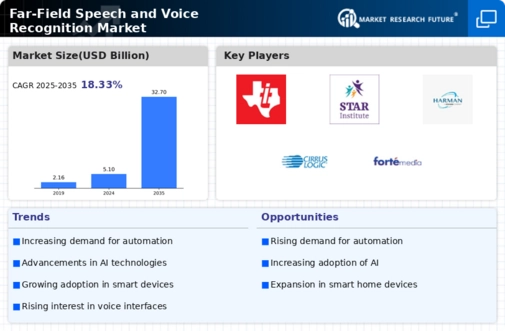-
Executive Summary
-
Market Attractiveness Analysis
-
Global Far-field Speech and Voice Recognition Market, by Microphone Solution
-
Global Far-field Speech and Voice Recognition Market, by Component
-
1.4
-
Global Far-field Speech and Voice Recognition Market, by Application
-
Global
-
Far-field Speech and Voice Recognition Market, by Region
-
Scope of the Report
-
Market Definition
-
Scope of the Study
-
Markets Structure
-
Key Buying Criteria
-
Macro Factor Indicator Analysis
-
Market
-
Research Methodology
-
Research Process
-
Secondary Research
-
3.3
-
Primary Research
-
Forecast Model
-
List of Assumptions
-
Market
-
Insights
-
Market Dynamics
-
Introduction
-
Drivers
-
5.3
-
Restraints
-
Opportunities
-
Challenges
-
Technological Trends
-
Regulatory Landscape/Standards
-
Market Factor Analysis
-
Supply/Value
- R&D
- Manufacturing
- Distribution
- Post-Sales Monitoring
-
Chain Analysis
-
& Sales
-
Porter’s Five Forces
- Threat of New Entrants
- Bargaining Power of Suppliers
- Bargaining Power of Buyers
- Threat of Substitutes
- Intensity
-
Model
-
of Rivalry
-
Global Far-field Speech and Voice Recognition Market, by Component
-
Introduction
-
Microphones
- Market Estimates & Forecast,
- Market Estimates & Forecast, by Region, 2024-2032
- Market Estimates & Forecast, 2024-2032
- Market Estimates & Forecast, by Region, 2024-2032
-
7.3
-
Digital Signal Processors
-
Software
- Market Estimates & Forecast, 2024-2032
- Market Estimates &
-
Forecast, by Region, 2024-2032
-
Global Far-field Speech and Voice Recognition
-
Market, by Microphone Solution
-
Introduction
-
Single Microphone
- Market Estimates & Forecast, 2024-2032
- Market Estimates &
-
Forecast, by Region, 2024-2032
-
Linear Arrays
- Market Estimates
- Market Estimates & Forecast, by Region,
-
& Forecast, 2024-2032
-
Circular Arrays
- Market Estimates & Forecast, 2024-2032
- Market Estimates & Forecast, by Region, 2024-2032
-
Global Far-field
-
Speech and Voice Recognition Market, by Application
-
Introduction
- Market Estimates & Forecast, 2024-2032
- Market Estimates & Forecast, by Region, 2024-2032
-
9.2
-
In-Vehicle Infotainment Systems
-
Smart TV
- Market Estimates & Forecast, 2024-2032
- Market Estimates &
-
Forecast, by Region, 2024-2032
-
Smart Speakers
- Market Estimates
- Market Estimates & Forecast, by Region,
-
& Forecast, 2024-2032
-
Robotics
- Market Estimates & Forecast, 2024-2032
- Market Estimates & Forecast, by Region, 2024-2032
-
Smart Thermostats
- Market Estimates & Forecast, 2024-2032
- Market Estimates &
-
Forecast, by Region, 2024-2032
-
Smart Lighting
- Market Estimates
- Market Estimates & Forecast, by Region,
-
& Forecast, 2024-2032
-
Others
- Market Estimates & Forecast, 2024-2032
- Market Estimates & Forecast, by Region, 2024-2032
-
Global Far-field
-
Speech and Voice Recognition Market, by Region
-
Introduction
- Market Estimates & Forecast, by Country, 2024-2032
- Market Estimates & Forecast, by Component, 2024-2032
- Market
- Market Estimates
- US
- Canada
-
10.2
-
North America
-
Estimates & Forecast, by Microphone Solution, 2024-2032
-
& Forecast, by Application, 2024-2032
-
& Forecast, 2024-2032
-
10.2.6.2
-
Market Estimates & Forecast, by Component, 2024-2032
-
& Forecast, by Microphone Solution, 2024-2032
-
& Forecast, by Application, 2024-2032
-
Estimates & Forecast, 2024-2032
-
by Component, 2024-2032
-
Solution, 2024-2032
-
10.3.4
-
Market Estimates
-
Market Estimates
-
Mexico
-
Market
-
Market Estimates & Forecast,
-
Market Estimates & Forecast, by Microphone
-
Market Estimates & Forecast, by Application,
-
Europe
- Market Estimates & Forecast, by Country,
- Market Estimates & Forecast, by Component, 2024-2032
- Market Estimates & Forecast, by Microphone Solution, 2024-2032
-
Market Estimates & Forecast, by Application, 2024-2032
-
& Forecast, by Component, 2024-2032
-
by Microphone Solution, 2024-2032
-
by Application, 2024-2032
-
10.3.7
-
France
-
Estimates & Forecast, by Component, 2024-2032
-
& Forecast, by Microphone Solution, 2024-2032
-
& Forecast, by Application, 2024-2032
-
Estimates & Forecast, 2024-2032
-
by Component, 2024-2032
-
Solution 2024-2032
-
10.4
-
Asia-Pacific
-
Estimates & Forecast, by Microphone Solution, 2024-2032
-
& Forecast, by Application, 2024-2032
-
Estimates & Forecast, 2024-2032
-
by Component, 2024-2032
-
Solution, 2024-2032
-
10.4.6.3
-
Germany
-
Market Estimates & Forecast, 2024-2032
-
Market Estimates
-
Market Estimates & Forecast,
-
Market Estimates & Forecast,
-
UK
-
Market Estimates & Forecast,
-
Market Estimates & Forecast, by Component, 2024-2032
-
Market Estimates & Forecast, by Microphone Solution, 2024-2032
-
Market Estimates & Forecast, by Application, 2024-2032
-
Market Estimates & Forecast, 2024-2032
-
Market
-
Market Estimates
-
Market Estimates
-
Italy
-
Market
-
Market Estimates & Forecast,
-
Market Estimates & Forecast, by Microphone
-
Market Estimates & Forecast, by Application,
-
Rest of Europe
-
Market Estimates & Forecast,
-
Market Estimates & Forecast, by Component, 2024-2032
-
Market Estimates & Forecast, by Microphone Solution, 2024-2032
-
Market Estimates & Forecast, by Application, 2024-2032
-
Market Estimates & Forecast, by Country, 2024-2032
-
Market Estimates & Forecast, by Component, 2024-2032
-
Market
-
Market Estimates
-
Japan
-
Market
-
Market Estimates & Forecast,
-
Market Estimates & Forecast, by Microphone
-
Market Estimates & Forecast, by Application,
-
China
-
Market Estimates & Forecast, 2024-2032
-
Market Estimates & Forecast, by Component, 2024-2032
-
Market Estimates & Forecast, by Microphone Solution, 2024-2032
-
10.4.6.4
-
Market Estimates & Forecast, by Application, 2024-2032
-
& Forecast, by Component, 2024-2032
-
by Microphone Solution, 2024-2032
-
by Application, 2024-2032
-
Estimates & Forecast, 2024-2032
-
by Component, 2024-2032
-
Solution, 2024-2032
-
by Region, 2024-2032
-
10.5.5
-
Middle East & Africa
-
10.5.5.3
-
India
-
Market Estimates & Forecast, 2024-2032
-
Market Estimates
-
Market Estimates & Forecast,
-
Market Estimates & Forecast,
-
Rest of Asia-Pacific
-
Market
-
Market Estimates & Forecast,
-
Market Estimates & Forecast, by Microphone
-
Market Estimates & Forecast, by Application,
-
Rest of the World
- Market Estimates & Forecast,
- Market Estimates & Forecast, by Component,
- Market Estimates & Forecast, by Microphone Solution, 2024-2032
- Market Estimates & Forecast, by Application, 2024-2032
-
Market Estimates & Forecast, by Microphone Solution, 2024-2032
-
10.5.5.4
-
Market Estimates & Forecast, by Application, 2024-2032
-
& Forecast, by Component, 2024-2032
-
by Microphone Solution, 2024-2032
-
by Application, 2024-2032
-
South America
-
Market Estimates & Forecast, 2024-2032
-
Market Estimates
-
Market Estimates & Forecast,
-
Market Estimates & Forecast,
-
Company Landscape
-
Competitive Overview
-
Competitor Dashboard
-
Major Growth Strategy in the Global Far-field
-
Speech and Voice Recognition Market
-
Competitive Benchmarking
- Product Launch/Service Deployment
- Mergers & Acquisitions
- Joint Ventures
-
11.5
-
Key Developments & Growth Strategies
-
Company
-
Profiles
-
Synaptics Inc.
- Company Overview
- Product/Business
- Financial Updates
- Key Developments
- Company Overview
- Product/Business
- Financial Updates
- Key Developments
- Company Overview
- Product/Business Segment
- Financial Updates
- Key Developments
-
Segment Overview
-
12.2
-
Texas Instruments Inc.
-
Segment Overview
-
12.3
-
Qualcomm Inc.
-
Overview
-
Sensory
- Company Overview
- Product/Business Segment Overview
- Financial Updates
- Key Developments
-
Inc.
-
STMicroelectronics
- Company Overview
- Product/Business Segment Overview
- Financial Updates
- Key Developments
-
NV
-
Harman International
- Company Overview
- Product/Business Segment
- Financial Updates
- Key Developments
-
Industries, Inc.
-
Overview
-
Andrea
- Company Overview
- Product/Business
- Financial Updates
- Key Developments
- Company Overview
- Product/Business Segment
- Financial Updates
- Key Developments
-
Electronics Corporation
-
Segment Overview
-
12.8
-
Cirrus Logic Inc.
-
Overview
-
Microsemi
- Company Overview
- Product/Business Segment Overview
- Financial Updates
- Key Developments
-
Corporation
-
DSP Group, Inc.
- Company Overview
- Product/Business Segment Overview
- Key Developments
-
12.10.3
-
Financial Updates
-
Knowles Corporation
- Company Overview
- Product/Business Segment Overview
- Key Developments
-
12.11.3
-
Financial Updates
-
Meeami Technologies,
- Company Overview
- Product/Business Segment Overview
- Financial Updates
- Key Developments
-
Inc.
-
Alango Technologies
- Company Overview
- Product/Business Segment Overview
- Financial Updates
- Key Developments
-
Ltd
-
Fortemedia,
- Company Overview
- Product/Business Segment Overview
- Financial Updates
- Key Developments
-
Inc.
-
VOCAL Technologies,
- Company Overview
- Product/Business Segment Overview
- Financial Updates
- Key Developments
-
Ltd
-
Conclusion
-
-
LIST OF TABLES
-
Global Far-field Speech and Voice Recognition
-
Market, by Region, 2024-2032
-
North America: Far-field Speech and Voice
-
Recognition Market, by Country, 2024-2032
-
Europe: Far-field Speech
-
and Voice Recognition Market, by Country, 2024-2032
-
Asia-Pacific: Far-field
-
Speech and Voice Recognition Market, by Country, 2024-2032
-
Middle East
-
& Africa: Far-field Speech and Voice Recognition Market, by Country, 2024-2032
-
South America: Far-field Speech and Voice Recognition Market, by Country,
-
Global Far-field Speech and Voice Recognition Microphone
-
Solution Market, by Region, 2024-2032
-
North America: Far-field Speech
-
and Voice Recognition Microphone Solution Market, by Country, 2024-2032
-
Table
-
Europe: Far-field Speech and Voice Recognition Microphone Solution Market, by
-
Country, 2024-2032
-
Asia-Pacific: Far-field Speech and Voice Recognition
-
Microphone Solution Market, by Country, 2024-2032
-
Middle East &
-
Africa: Far-field Speech and Voice Recognition Microphone Solution Market, by Country,
-
South America: Far-field Speech and Voice Recognition Microphone
-
Solution Market, by Country, 2024-2032
-
Global Far-field Speech and
-
Voice Recognition Application Market, by Region, 2024-2032
-
North America:
-
Far-field Speech and Voice Recognition Application Market, by Country, 2024-2032
-
Europe: Far-field Speech and Voice Recognition Application Market, by
-
Country, 2024-2032
-
Asia-Pacific: Far-field Speech and Voice Recognition
-
Application Market, by Country, 2024-2032
-
Middle East & Africa:
-
Far-field Speech and Voice Recognition Application Market, by Country, 2024-2032
-
South America: Far-field Speech and Voice Recognition Application Market,
-
by Country, 2024-2032
-
Global Microphone Solution Market, by Region,
-
Global Application Market, by Region, 2024-2032
-
Table
-
North America: Far-field Speech and Voice Recognition Market, by Country
-
Table
-
North America: Far-field Speech and Voice Recognition Market, by Microphone Solution
-
North America: Far-field Speech and Voice Recognition Market, by Application
-
Europe: Far-field Speech and Voice Recognition Market, by Country
-
Europe: Far-field Speech and Voice Recognition Market, by Microphone
-
Solution
-
Europe: Far-field Speech and Voice Recognition Market, by
-
Application
-
Asia-Pacific: Far-field Speech and Voice Recognition Market,
-
by Country
-
Asia-Pacific: Far-field Speech and Voice Recognition Market,
-
by Microphone Solution
-
Asia-Pacific: Far-field Speech and Voice Recognition
-
Market, by Application
-
Middle East & Africa: Far-field Speech
-
and Voice Recognition Market, by Country
-
Middle East & Africa:
-
Far-field Speech and Voice Recognition Market, by Microphone Solution
-
Table
-
Middle East & Africa: Far-field Speech and Voice Recognition Market, by Application
-
South America: Far-field Speech and Voice Recognition Market, by Country
-
South America: Far-field Speech and Voice Recognition Market, by Microphone
-
Solution
-
South America: Far-field Speech and Voice Recognition Market,
-
by Application
-
LIST OF FIGURES
-
Global Far-field Speech
-
and Voice Recognition Market Segmentation
-
Forecast Methodology
-
Porter’s Five Forces Analysis of the Global Far-field Speech and
-
Voice Recognition Market
-
Value Chain of the Global Far-field Speech
-
and Voice Recognition Market
-
Share of the Global Far-field Speech
-
and Voice Recognition Market in 2023, by Country (in %)
-
Global Far-field
-
Speech and Voice Recognition Market, 2024-2032
-
Global Far-field Speech
-
and Voice Recognition Market Size, by Microphone Solution, 2023
-
Share
-
of the Global Far-field Speech and Voice Recognition Market, by Microphone Solution,
-
Global Far-field Speech and Voice Recognition Market Size,
-
by Application, 2024-2032
-
Share of the Global Far-field Speech and
-
Voice Recognition Market, by Application, 2024-2032









Leave a Comment